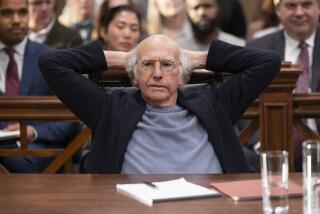Q&A: With ‘Laugh-In,’ not much has changed — on the show or in the world

Sure, catchphrases like “Here comes the judge!” and “Sock it to me!” and such characters as Ernestine the telephone operator and dirty old man Tyrone F. Horneigh made “Rowan & Martin’s Laugh-In” a part of TV history. However, we might never have heard of any of them were it not for the Grammy Awards. Or, more accurately, the lack of a Grammy Awards.
“The show was an accident. NBC never meant to buy it,” says “Laugh-In” creator-executive producer George Schlatter. “I’d been working on an NBC show called ‘Best on Record,’ which was an earlier version of the Grammy Awards but before they could afford to actually pay for the awards. They’d asked me to keep doing it but I said I would only if I could do one show my way with no interference or rules. They said yes without really meaning it. And that’s what became ‘Laugh-In.’”
Schlatter launched the sketch comedy series in January 1968 (after a special aired in fall 1967). It would go on to become the most-watched series on television in its first two seasons and win two Emmys for variety, music or comedy series. Now, some 51 years later, Netflix is paying tribute to “Laugh-In’s” legacy with a special, “Still Laugh-In: The Stars Celebrate,” that mixes classic clips from the show with new bits performed in front of a live audience by current stars like Tiffany Haddish, Neil Patrick Harris and Rob Riggle. The Envelope spoke with Schlatter about working with Netflix, how he helped elect a president and whether the time is right for another “Laugh-In.”
How did the Netflix special come about?
I told Ted (Sarandos, Netflix’s chief content officer) last year that it was going to be our 50th anniversary and I was going to do some kind of special to celebrate. He said he wanted to be a part of it and I have to say, it was a wonderful experience to get to do this and go back in time revisiting our episodes. It was so gratifying when we taped the special to see the enormity of the reaction to jokes that were 50 years old. It was like going through a time warp.
Does it feel like 50 years have passed?
Actually, it feels like we’re in an identical time now to that period when “Laugh-In” was on. Think about it. In 1968 we were involved in an unpopular war. We had an unpopular president. There was unrest all over the world. There was a generation gap, a struggle for gay rights, racial injustice … it’s the same problems we have today. We haven’t solved one thing. Which is why I think the Netflix show works so well.
“Laugh-In” had a lot of jokes going after taboo topics like the president and the Vietnam War. Did the network ever tell you to knock it off and play nice?
When we first ran the show for NBC, they were really upset and said, “What the hell is this?” We said, “It’s a comedy show.” They said, “It doesn’t make any sense.” We said, “Now you’re getting it!” They said, “This is supposed to be a television show.” I said, “The audience laughed and they’re smarter than you are.” So NBC aired the show reluctantly, sure it was going to fail. By the end of the first year, we were doing a 50 share and could go in and do anything we wanted.
Is there anything you look back on that maybe didn’t go as planned?
It may probably be the most famous of our cameos, which was with Richard Nixon when he was running for president. I wanted to do something special for our second season because we were so hot and I felt we had to boost ourselves above that. One of our writers, Paul Keyes, was a friend of Nixon’s, and Paul suggested maybe we could get him. So we went over to CBS, where he was doing a press conference, and told him, “Mr. Nixon, can you just say, ‘Sock it to me?’” He went, “Sock it to me” in a real angry way, and we said, “No, sir.” He smiled and said, “OK, comedy is new for me.” When he said, “Take 2!” and held three fingers up in the air to start again, I knew we were home free. We put it on the air as quickly as we could. It exploded, and there are those who say we were responsible for putting Nixon into the mainstream. They say it’s possible we helped elect him, and that’s a burden I’ve had to live with for 50 years.
Do you ever think about what “Laugh-In” would be like now if you brought it back for more than just a Netflix special?
We did everything on “Laugh-In” already. What would we do now? You can’t find anyone funnier than Goldie Hawn or Ruth Buzzi or Arte Johnson. The material is there with the political situation we’re now in, and the technical advances are great. Still, it’s like having an affair with an old girlfriend. It was wonderful and you enjoyed it and would love to go back for a guest shot but you also don’t want to go back permanently. There’s so much else left to do.
You have several current comics in the Netflix special, like Tiffany Haddish and Natasha Leggero, along with “Laugh-In” veterans like Buzzi, Lily Tomlin and Jo Anne Worley. Did you enjoy bringing the generations of comedy together?
It was a real adventure because it moved me out of a time warp. Netflix was actually the one that said their audience is young and contemporary, so they wanted contemporary people mixed in with the more traditional people. That gave the special a balance that I think really worked. We went around to see all the young, currently hip comics, so I looked at a lot of stuff, and every one of those people I saw reminded me comedy may be our salvation. Comedians are the only ones who can tell the emperor he’s naked and not very well endowed. That’s the panacea, the buffer, both in times like these and when “Laugh-In” was on. Nobody throws a punch when they’re laughing. But we’re getting close.
More to Read
From the Oscars to the Emmys.
Get the Envelope newsletter for exclusive awards season coverage, behind-the-scenes stories from the Envelope podcast and columnist Glenn Whipp’s must-read analysis.
You may occasionally receive promotional content from the Los Angeles Times.






